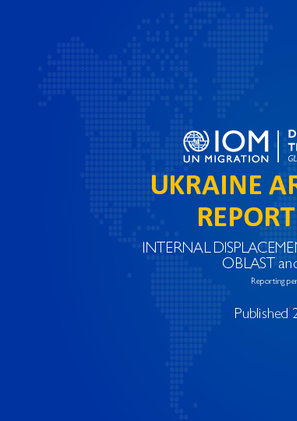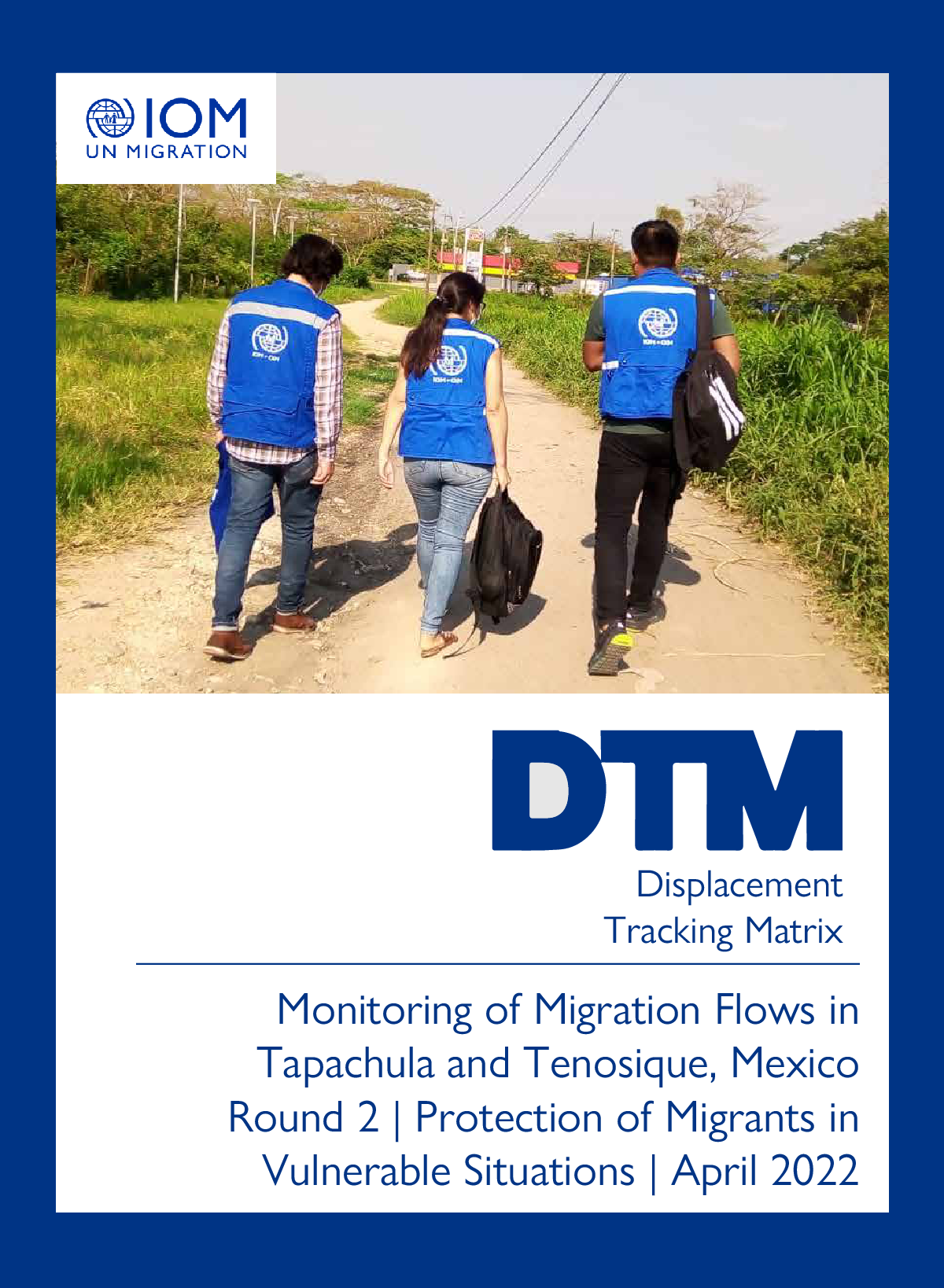-
Countries
-
Data and Analysis
-
Special Focus
-
Crisis Responses

Contact
DTM Europe, DTMMediterranean@iom.int
Language
English
Location
Republic of Moldova
Period Covered
Mar 09 2022
May 12 2022
Activity
- Survey
- Flow Monitoring
As the war in Ukraine has entered its fourth month, the civilian population is bearing the burden of ongoing hostilities. Since the onset of the war, refugees from Ukraine and Third Country Nationals (TCNs) not in need of international protection have been fleeing from Ukraine to the Republic of Moldova. From 24 February to 12 May 2022, the Moldovan authorities have reported a cumulative total of 459,608 arrivals from Ukraine into the Republic of Moldova, of whom 420,772 (91.6%) are Ukrainian refugees and 38,836 (8.4%) TCNs (Source: General Inspectorate for Border Police).
This is the fourth fact sheet that summarizes the findings of the displacement survey conducted by the International Organization for Migration (IOM), in partnership with UN Women, to assess the humanitarian needs and intentions of refugees from Ukraine and TCNs fleeing into the Republic of Moldova from Ukraine. This report presents an analysis based on the 12,814 interviews conducted between 09 March and 12 May 2022, out of which 11,881 interviews took place in entry and exit border crossing points (BCPs): Otaci, Palanca and Tudora (entry from Ukraine), and Giurgiulesti, Leuseni (exit towards Romania), and in transit centres in Chisinau: Moldexpo, the Ukrainian Consulate and the main bus station. Additionally, 933 interviews were conducted in reception centres and private accommodations.

Contact
DTM Europe, DTMMediterranean@iom.int
Language
English
Location
Republic of Moldova
Period Covered
Feb 24 2022
Jun 20 2022
Activity
- Flow Monitoring
- Migrants presence
Between 24 February and 20 June 2022, Ukrainian refugees represent 92 per cent (463,305) of all individuals registered at entry from Ukraine (UKR) to the Republic of Moldova (MDA). The remaining eight per cent (42,488) are other TCNs. Similarly, Ukrainian refugees represent 90 per cent (278,400) of all individuals registered while leaving the Republic of Moldova towards Romania during the reporting period and the remaining 10 per cent (32,013) are TCNs.
This report focuses on trends of TCNs from Ukraine to the Republic of Moldova, analyzing data about their stay or their subsequent movement out of the country.

Contact
DTM Libya, DTMLibya@iom.int
Language
English
Location
Libya
Period Covered
May 29 2022
Jun 04 2022
Activity
- Other
As part of the third phase of the Libyan national COVID-19 vaccination campaign led by the Libyan National Centre for Disease Control (NCDC), IOM conducted awareness raising sessions on COVID-19 vaccines with a total of 232 adult migrants in two locations, Hai Alandalus and Ain Zara community settings. Additionally, 645 (631 migrants and 14 Libyans) have received COVID-19 vaccination in five locations during the reporting period (29 May - 4 Jun 2022)

Contact
DTM Libya, DTMLibya@iom.int
Language
English
Location
Libya
Period Covered
Jun 05 2022
Jun 11 2022
Activity
- Other
As part of the third phase of the Libyan national COVID-19 vaccination campaign led by the Libyan National Centre for Disease Control (NCDC), IOM conducted awareness raising sessions on COVID-19 vaccines with a total of 148 adult migrants (13 Females and 135 Males) in two detention centres and a community setting in Tripoli municipality. Additionally, 142 (140 migrants and 2 Libyans) have received COVID-19 vaccination in four locations during the reporting period (5 - 11 June 2022).

Contact
DTMMozambique@iom.int
Language
English
Location
Mozambique
Period Covered
Jun 02 2022
Jun 20 2022
Activity
- Mobility Tracking
- Event Tracking
Fear of attacks and subsequent confirmed attacks in Ancuabe district by Non-State Armed Groups triggered the movements of 24,462 individuals within Ancuabe, Chiure, Quissanga, Balama, Mecufi, Mueda, Macomia, Montepuez, Meluco, Namuno, Nampula, Balama, Metuge and Cidade de Pemba. Approximately 1,186 IDPs have been identified with vulnerabilities. At least 39% of these movements are arrivals in Cidade de Pemba and 27% in Chiure. New arrivals recorded within the reporting period map 10,180 individuals predominantly moving into sites across Chiure, Metuge, Montepuez and Ancuabe.
The objective of the Emergency Tracking Tool (ETT) - Movement Alert is to collect information on large and sudden population movements, and to provide support to humanitarian response partners by disseminating data on (Internally displaced persons) IDPs for ensuring effective humanitarian response to the affected population. Information is collected through key informant interviews or direct observation. The dashboard provides basic information on displacements, and additional information can be shared upon request. IOM identified 20,339 individual displacement movements in the previous reporting period (02-16 June). Impact of new attacks reported between 9 and 19 June in Ancuabe and Chiure districts account for the increase of displacement movements representing 24,462 individuals. Current figures are to be considered as cumulative displacement movements observed between 02-20 June.

Contact
DTMUkraine@iom.int
Language
Ukrainian
Location
Ukraine
Period Covered
Jun 01 2022
Jun 11 2022
Activity
- Mobility Tracking
- Baseline Assessment
Починаючи з 24 лютого 2022 року війна в Україні спричинила безпрецедентну гуманітарну кризу в усіх адміністративних підрозділах (областях) країни. З 1-го по 11 червня Міжнародна організація з міграції (МОМ) провела базову оцінку території 728 громад, які приймають зареєстрованих внутрішньо переміщених осіб у Закарпатській, Львівській, Івано―Франківській, Чернівецькій, Хмельницькій, Волинській, Вінницькій, Житомирській, Кіровоградській та Полтавській, Одеській, Тернопільській, Київській областях, щоб отримати початкове уявлення про внутрішнє переміщення.
Проведення цієї рутинної оцінки підтримує цільове призначення та надання гуманітарної допомоги постраждалим населенням і служить попереднім джерелом для виявлення громад з високим рівнем переміщення.

Contact
DTMMozambique@iom.int
Language
English
Location
Mozambique
Period Covered
Jun 02 2022
Jun 20 2022
Activity
- Mobility Tracking
- Event Tracking
Fear of attacks and subsequent confirmed attacks in Ancuabe and Chiure district by Non-State Armed Groups triggered the movements of 23,567 individuals to Nampula province, in the districts of Erati, Malema, Meconta, Memba, Mogincual, Nacala, Ribaue and Cidade de Nampula. Approximately 69 Internally Displaced Persons (IDPs) IDPs have been identified with vulnerabilities. At least 81% of these movements are arrivals from Chiure, 10% from Mecufi and 9% from Ancuabe districts. Estimated 23,567 individuals arrived in Erati district, which is main entrance of Nampula province.
The objective of the Emergency Tracking Tool (ETT) - Movement Alert is to collect information on large and sudden population movements, and to provide support to humanitarian response partners by disseminating data on IDPs for ensuring effective humanitarian response to the affected population. Information is collected through key informant interviews or direct observation. The dashboard provides basic information on displacements, and additional information can be shared upon request. Impact of new attacks reported between 9 and 19 June in Ancuabe and Chiure districts account for the increase of displacement movements representing 23,567 individuals. Current figures are to be considered as cumulative displacement movements observed between 02-20 June.

Contact
DTMUkraine@iom.int
Language
English
Location
Ukraine
Period Covered
Jun 01 2022
Jun 11 2022
Activity
- Mobility Tracking
- Baseline Assessment
Starting on 24 February 2022, the war in Ukraine triggered an unprecedented humanitarian crisis across the country. Between 1 and 11 June the International Organization for Migration (IOM) conducted an area baseline assessment of 728 hromadas hosting IDPs in Zakarpatska, Lvivska, Ivano-Frankivska, Chemivetska, Kirovohradska, Kyivska, Odeska, Temopilska, Vinnytska, Volynska, Khmelnytska, Zhytomyrska, and Poftayska oblasts in order to gather initial trends on the number and geographic location of officially recorded internally displaced persons.
This routine assessment supports the targeting and provision of humanitarian assistance to the affected population and serves as a preliminary source to identify oblasts and hromadas hosting high numbers of IDPs.

Contact
Laura Canché, lcanche@iom.int; Miranda Mora, mirmora@iom.int
Language
English
Location
Mexico
Period Covered
Apr 01 2022
Apr 30 2022
Activity
- Flow Monitoring Survey
- Mobility Tracking
- Event Tracking
Context
Tapachula (State of Chiapas), and Tenosique (State of Tabasco), are the main receiving cities for migrants in southern Mexico. In 2021, the arrival records of the migrant population that entered Mexico through the southern border were broken, according to the records of the Mexican Commission for Refugee Assistance (COMAR), which reported 89,636 applications for recognition of refugee status in Tapachula and 7,153 applications in Tabasco.
During the second semester of the year in question, the services for migrants in the city of Tapachula presented greater demand, in the month of November the National Institute of Migration (INM) through the provision of buses transferred migrants to other states such as Puebla , Querétaro, Hidalgo, State of Mexico, Guanajuato, Sonora, Colima and Jalisco to continue with their procedures. According to the Migration Policy Unit (UPMRIP), during 2021, 307,679 events of foreigners presented or channeled by the immigration authority were registered, of which 76,333 were registered in Chiapas and 44,008 in Tabasco.
Methodology
The Displacement Tracking Matrix (DTM) is a system to track and monitor displacement and population mobility. This study used the mobility tracking and surveys components, which are designed to quantify the presence of migrants and generate data for understanding their socioeconomic and migratory characteristics.
The study consists of three rounds of monitoring. This report gives the results of round two, corresponding to April 2022, and focuses on the findings regarding the protection of vulnerable migrants.
The cities serving as study areas are Tapachula in Chiapas and Tenosique in Tabasco, both border sites in southern Mexico.
The round two surveys of migrants were conducted during the first week of April from Monday, April 4, to Friday, April 8. In both cities, spaces such as parks, plazas, shelters, and shelter surroundings were selected as high migrant concentration points.
Out of a total of 323 interviews, 321 were effective and two were invalid (the required consent was not given); 69% of the interviews were conducted in Tapachula and 31% in Tenosique. Probability sampling, clustered by high migrant concentration points, was used.
Contact
DTMUkraine@iom.int
Location
Ukraine
Activity
- Mobility Tracking
- Baseline Assessment
Period Covered
Jun 01 2022 -Jun 11 2022
A baseline assessment is a sub-component of mobility tracking. It aims to collect data on IDP, migrant or returnee population presence in a defined administrative area of the country.
Population Groups
Survey Methodology
Unit of Analysis Or Observation
Type of Survey or Assessment
Keywords
Geographical Scope
Administrative boundaries with available data
The current dataset covers the following administrative boundaries
